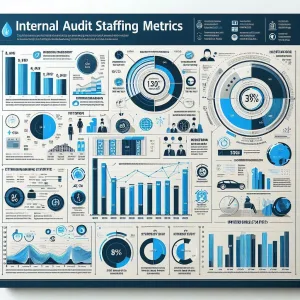Continuous monitoring is a pivotal concept in internal audit that empowers organizations to proactively manage risks and enhance their operational efficiency. By continuously assessing and evaluating risk management processes, internal auditors can ensure that controls remain effective and aligned with evolving business needs and regulatory requirements. This blog post delves into the benefits and challenges of continuous monitoring, providing insights for internal auditors preparing for the CMA examination [1].
Continuous monitoring refers to the ongoing process of identifying, analyzing, and mitigating risks as they evolve over time. As an internal auditor, understanding the importance of continuous monitoring is crucial for maintaining a robust risk management framework. This proactive approach enables organizations to identify risks in real-time, allowing for prompt action to mitigate or manage those risks before they escalate into major issues.
The benefits of continuous monitoring are multifaceted:
- Real-Time Risk Identification: Organizations can identify risks promptly, reducing the likelihood and impact of adverse events, such as data breaches or financial losses.
- Reduced Audit Scope: Continuous monitoring minimizes the need for extensive audit testing, allowing auditors to focus on high-risk areas and allocate resources efficiently.
- Enhanced Organizational Culture: It fosters transparency, accountability, and collaboration across the organization, building trust among stakeholders.
To implement continuous monitoring effectively (key topic for CMA examination), internal auditors should focus on key elements [2]:
- Establish a robust risk management framework.
- Develop and maintain a comprehensive control inventory.
- Continuously evaluate and update controls.
- Monitor and analyze data from various sources.
Benefits of Continuous Monitoring for Internal Audit
Incorporating continuous monitoring into internal audit practices offers numerous advantages:
- Reduced Audit Frequency and Scope: Continuous monitoring allows for early identification of high-risk areas, minimizing the need for comprehensive audits.
- Improved Risk Management: Real-time monitoring and reporting enhance the ability to address potential issues proactively.
- Enhanced Stakeholder Confidence: Timely identification and mitigation of risks demonstrate a commitment to sound governance practices.
By continuously tracking and analyzing key performance indicators (KPIs), internal auditors can identify emerging risks before they impact organizational performance. This proactive approach facilitates data-driven decision-making and strengthens stakeholder trust [3].
Challenges Associated with Continuous Monitoring
While continuous monitoring offers significant benefits, it also presents challenges (which are important to consider for your CMA examination):
- Resource Constraints: Limited staffing, technology, and budget resources can hinder effective implementation.
- Data Quality Issues: Ensuring data accuracy, completeness, and timeliness is essential for effective monitoring.
- Balancing Approaches: Internal auditors must balance continuous monitoring with traditional audit methods to ensure comprehensive risk coverage.
To overcome these challenges, consider the following strategies [4]:
- Develop a phased approach to implementation, focusing on high-risk areas first.
- Invest in data analytics tools that support real-time monitoring.
- Provide ongoing training for staff to enhance their skills in continuous monitoring.
Implementing Continuous Monitoring for the CMA examination
As you prepare for the CMA examination, understanding the role of continuous monitoring in risk management and audit planning is crucial. Here’s how to apply these concepts:
Key Areas for Continuous Monitoring:
- Financial Reporting: Monitor financial statement preparation and accounting policies to identify discrepancies.
- Compliance: Ensure adherence to regulatory requirements and organizational policies through continuous oversight.
- IT Systems: Identify vulnerabilities in IT systems to secure data effectively.
Steps for Implementation:
- Assess Current Processes: Evaluate existing risk management and audit processes.
- Identify Key Risks: Determine critical risks and develop mitigation strategies.
- Develop Monitoring Tools: Utilize dashboards or alerts to track performance.
- Establish a Framework: Define roles and responsibilities for continuous monitoring.
- Monitor and Review Results: Regularly assess the effectiveness of monitoring initiatives.
Key Takeaways
- Continuous monitoring is essential for effective internal audit practices.
- It enhances risk management, reduces audit scope, and fosters stakeholder confidence.
- Internal auditors must address challenges related to resources and data quality.
- Practical implementation involves assessing processes, identifying risks, and developing monitoring tools.
FAQ: Continuous Monitoring in Internal Audit
What is continuous monitoring in internal audit?
Continuous monitoring is the ongoing process of assessing and managing risks to ensure that controls remain effective and aligned with business needs.
How does continuous monitoring benefit internal auditors?
It allows auditors to identify risks in real-time, reduces the scope of audits, and enhances stakeholder confidence through timely risk management.
What challenges do internal auditors face with continuous monitoring?
Challenges include resource constraints, data quality issues, and the need to balance continuous monitoring with traditional audit approaches.
Conclusion: Maximizing the Value of Continuous Monitoring
In conclusion, continuous monitoring (one of the key topics for CMA examination) is a vital component of any effective internal audit function. Its benefits are multifaceted, ranging from enhanced risk management to increased organizational resilience. As internal auditors, it is our responsibility to lead the effort in integrating continuous monitoring into our practices, ensuring that we provide value-added services that support organizational objectives [5]. By embracing a culture of ongoing evaluation and improvement, organizations can navigate the complexities of their operating environments with greater confidence and effectiveness.
Ultimately, the successful implementation of continuous monitoring requires a commitment to collaboration, clear objectives, and open communication with stakeholders [6]. By doing so, we can unlock the full potential of our internal audit function and contribute meaningfully to our organizations’ risk management efforts.
Find out more about Shaun Stoltz https://www.shaunstoltz.com/about/
This post was written by an AI and reviewed/edited by a human.



